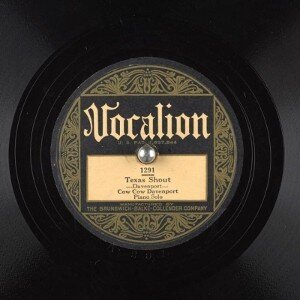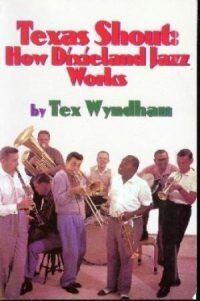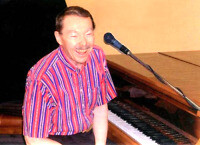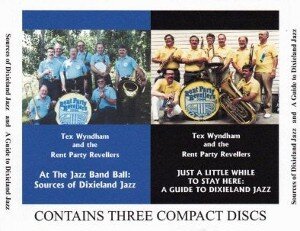 Set forth below is the third “Texas Shout” column, reprinted from the February 1990 issue of The American Rag (then West Coast Rag). It was the first such column to discuss the defining characteristics, strengths and weaknesses of a Dixieland jazz style.
Set forth below is the third “Texas Shout” column, reprinted from the February 1990 issue of The American Rag (then West Coast Rag). It was the first such column to discuss the defining characteristics, strengths and weaknesses of a Dixieland jazz style.
I have identified seven such styles: white New Orleans, hot dance, downtown New Orleans, Chicago, uptown New Orleans, West Coast revival and British trad. Eventually I wound up writing a similar essay about each of them. Because some styles took more than one issue to discuss fully, they consumed twelve of the total of seventy-five columns, thus comprising the most extensive single topic covered during the days of “Texas Shout”.
Hot Dance
Festivals wishing to present the full spectrum of pre-swing (i.e., Dixieland) jazz styles customarily include combos playing “hot dance” music. Like many terms emerging from popular culture, “hot dance” is not the best name that could have been selected for the particular type of jazz it describes.
As a result, I have encountered some misconceptions about hot dance music which I’ll mention and try to clear up below. In addition, I’ve never seen anyone attempt a useful working definition of “hot dance” in musical terms. So, for the benefit of festivalgoers and other interested listeners, I’ll provide you with one:
“Hot dance” is a pre-swing, or Dixieland, jazz style in which the ensemble passages are generally arranged (either via written scores or memorized voicing), leaving only the solo passages available for improvisation.
To properly understand that definition, you should be sure not to confuse an “arrangement” with a “routine”. A routine is a common understanding among the musicians as to when certain strains of the selection will be performed, where the key changes and breaks are, and which instruments are to be playing at which times. It need not involve an arrangement.
All jazz performances have to have routines, even if they are the common ensemble-solos-ensemble jam formats handled spontaneously on the bandstand by having the leader point his finger at the next soloist. Many Dixieland standards have very complex routines. “Tiger Rag” is an example of a tune that has an extremely tricky routine — one which all seasoned Dixielanders know, but which is rarely rendered via an arrangement.
Musicians will sometimes casually refer to the routine as the “chart” or, less accurately, as the “arrangement”. However, an arrangement, in the sense we are using it here, applies to musical passages which are voiced in advance so that the instrumentalist is given little or no choice as to the notes he is to play during those passages.
With those ideas in mind, let’s address two misconceptions regarding hot dance. The first is the notion that hot dance is an exclusively big-band idiom. The second is the notion that hot dance is not jazz, or that it has some lower amount of jazz content than other Dixieland styles.
It is true that a large group playing twenties-style jazz will be a hot dance band. Once you have more than eight instruments, you pretty much have to voice the ensembles to keep everyone from getting in each other’s way. In that sense, hot dance may be thought of loosely as the big-band jazz style of the twenties just as swing was the big-band jazz style of the thirties.
However, a smaller combo may elect to arrange its ensembles on some or all of its tunes, and will thereby become a hot dance band, just as there are swing combos that have fewer sidemen than a typical thirties swing band. The Stomp Off label has, in recent years, released a number of fine hot dance albums by groups using the conventional seven-or-fewer Dixieland lineup. One of the most popular thereof is the Hot Antic Jazz Band which uses the doubling talents of its five (sometimes) six musicians and very intricate arrangements to evoke the feeling of a larger unit.
To address the second misconception, hot dance is most emphatically a jazz style. In fact, that’s what the word “hot” tells you. If the performance is not a jazz performance, then it is ordinary dance music. Thus, it is not proper to use “hot dance” as a catchall term for any twenties-style pop music.
How do you tell if you’re hearing a hot dance performance? First, you satisfy yourself that it is, on the whole, a jazz performance — i.e., its main focus is on using jazz licks and jazz phrasing, played with a jazz feeling. Second, you satisfy yourself that it is a Dixieland performance — i.e., it deliberately avoids the jazz licks and conventions of swing or of other advanced jazz styles. Third, you listen to try to determine whether the ensembles you’re hearing, for the most part, must have been voiced in advance. If all three tests are passed, you have hot dance.
In most cases, you will be able to detect an arrangement fairly easily — usually there’s not much point in arranging something unless you’re trying for an effect that wouldn’t happen spontaneously. However, if the band is doing a note-for-note re-creation of a performance that was originally fully improvised — let’s say the 12/8/27 OKeh 78 of “China Boy” by McKenzie and Condon’s Chicagoans — the result ideally would sound just the same as the original.
Why, you may ask, should a style of jazz be defined in a way that might not make it identifiable from listening to it? One answer to that question is that, whether one realizes it or not, all jazz styles can only be validly defined in terms of what the musicians are trying to do.
Musicians who operate under exactly the same rules and objectives are inevitably playing the same style of jazz — some better, some worse, some bringing their own distinctive sounds and ideas to it, but they could all sit in with each other’s bands and get along. It’s only when you change one or more of those rules, say to put more emphasis on soloing, or on fancy repertoire, etc., that you move to a new style. Usually, those changes will be fairly obvious to a seasoned listener, but that need not necessarily be the case.
Another answer to that question is that the skills required to play hot dance are substantially different from those required to play other styles of Dixieland jazz. To function effectively in hot dance, a musician must be able to execute written or memorized arrangements with a proper jazz phrasing and a feeling of spontaneity. For other styles of Dixieland, a musician need not be able to read music or to fit in with scored voices. In Chicago style, for example, where the solo is the focus of the performance, it will be sufficient if he is a talented and creative soloist. (By the way, the subject of Dixieland skills is really a larger one that needs a column of its own.)
Note that it is the performance, not the band, that determines the style of jazz. Most bands can only play convincingly in one style and are not interested in playing other styles, so that it would be proper to refer to them as “uptown New Orleans” or “West Coast revival” style bands. Other groups, however, may take a more eclectic outlook.
One such group, fondly remembered as one of the best of the twenties white hot dance bands, was the Coon-Sanders Original Nighthawk Orchestra. However, listening to its overall output reveals that many of its recording are straight non-jazz dance music. It wasn’t until the Nighthawks began waxing jazz-permeated material like “High Fever” and “Roodles” that they became a jazz — i.e., a hot dance — orchestra.
This characteristic is more typical of groups that like to play hot dance. Some of their selections will be hot dance numbers, some (if the band is small enough) might be fully improvised, and some might be conventional dance tunes. Failure to notice this difference causes bands like, e.g., Paul Whiteman‘s twenties band, to be too casually referred to as hot dance bands. Actually, most Whiteman performances are not primarily focused on jazz, despite the presence of Bix and other famous jazzmen. They are essentially ordinary dance music, spiced up in isolated portions by an overlay of jazz.

One point may bother some of those who have wanted to dismiss hot dance as being some kind of weak sister in the Dixieland field. The pre-swing recordings of the great Negro orchestras such as Moten, Ellington, and Henderson are properly characterized as hot dance sides. That is, from a technical point of view, the members of those orchestras were given exactly the same assignment as the Coon-Sanders musicians — read the arrangement and play hot solos.
Calling early Ellington and Henderson “hot dance” may disturb fans who feel that such outstanding groups should not be lumped into the same category as the lesser-quality white hot dance bands. In this instance, one needs to realize two things: (1) In all styles of jazz, there will be musicians who are much, much better at what they’re doing than other musicians. (2) In the twenties, the Black jazz orchestras were so far ahead of their white counterparts that comparisons are hardly possible.
Black bands displayed a much more pervasive jazz feeling, and far superior soloists, than the whites. Had Ellington’s crew waxed the Coon-Sanders arrangement of “Brainstorm” while the Nighthawks were waxing the Ellington score of “The Mooche”, each would have known exactly what it was supposed to do. However, in that case, I feel sure that the Ellington rendition would have been so superior that today’s Dixielanders would have made “Brainstorm” into the quasi-standard that “The Mooche” has become, and the latter tune would have fallen more by the wayside.
By the way, I would like to emphasize that my use of Coon-Sanders for illustrative purposes here is not meant in any way to denigrate the output of a band whose best records are every bit as memorable as its many present-day fans testify. One hardly needs to apologize for not consistently operating at the level of an Ellington.
Finally, and most importantly, what is the best way to enjoy hot dance music? You do so by focusing mostly on the arrangement. Has the arranger made imaginative use of his resources, giving you a pleasing yet distinctive mix of sounds? Has he found combinations that bring out special features of the composition, or shown you a vision of it that you hadn’t anticipated? Does the band handle the arrangement crisply, with the sections functioning as a unit with no rough edges? And, with regard to solos, do the soloists have the skill to carry their passages and provide the build that the arrangement contemplates?
Developing an appreciation of such matters will more than compensate you at your next festival when you decide to take off a set from a diet of free-wheeling let-it-all-hang-out jamming to catch the hot dance combo. Anyway, for fans or would-be fans of hot dance, I hope that the above provides you with a basis for more easy access to a fine and valid style of Dixieland.
Back to the Texas Shout Index.

The full run of “Texas Shout” has been collected into a lavishly illustrated trade paperback entitled Texas Shout: How Dixieland Jazz Works. This book is available @ $20.00 plus $2.95 shipping from Tex Wyndham, On request, Tex will autograph the book and add a personalized note (be sure to tell him to whom the note should be addressed).
Tex Wyndham’s 3 CD Guide to Dixieland with music and commentary is available for $20 plus $2.95 shipping. The separate CD, A History of Ragtime: Tex Wyndham Live At Santa Rosa, is available for $13.00 plus $2.00 shipping. On request, Tex will autograph the inner sleeve and add a personalized note (be sure to tell him to whom the note should be addressed).
Send payment to Tex Wyndham, P.O. Box 831, Mendenhall, PA 19357, Phone (610) 388-6330.
Note: All links, pictures, videos or graphics accompanying the Shouts were added at the discretion of the Syncopated Times editorial staff. They did not accompany the original columns and do not necessarily reflect the opinion of Tex Wyndham.
From roughly 1970-2010, Tex Wyndham was: (1) one of the best-known revivalist Dixieland jazz musicians in the US, as cornetist, pianist and bandleader, (2) one of the best-known ragtime pianists in the US, and (3) one of the most respected critics in the US of Dixieland jazz, ragtime, and related music. He is the only person about whom all three of those statements can be made.


















